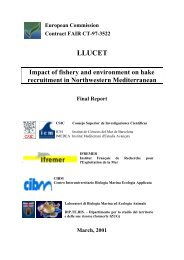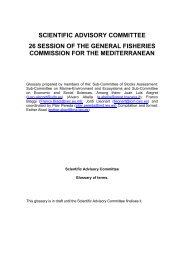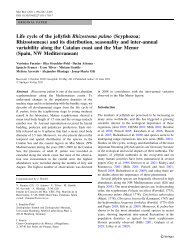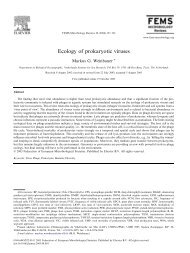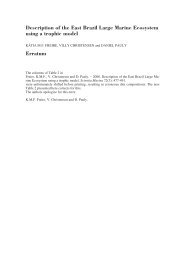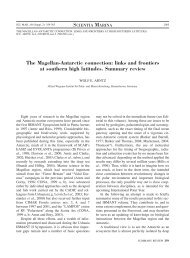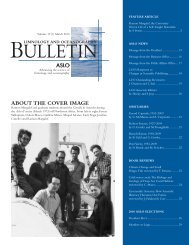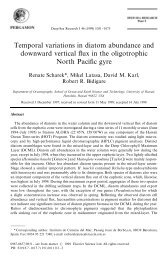REPORT OF THE WORKSHOP ON TRAWL SURVEY ... - FAO.org
REPORT OF THE WORKSHOP ON TRAWL SURVEY ... - FAO.org
REPORT OF THE WORKSHOP ON TRAWL SURVEY ... - FAO.org
You also want an ePaper? Increase the reach of your titles
YUMPU automatically turns print PDFs into web optimized ePapers that Google loves.
are each divided into two separate historical series due to a change from Granton trawl to<br />
GOV trawl in 1992 in the English survey and from RV Scotia II to RV Scotia III in the<br />
Scottish survey in 1998. This was considered a better option than using single series with<br />
calibration factors.<br />
The IBTS Q1 and ScGFS survey series both had data from 2006 available to the WGNSSK<br />
meeting in 2006. As XSA cannot handle survey data after the last year with fishery catch data,<br />
the IBTSQ1 survey series was treated as if it took place at the end of the previous year. The<br />
ages and years in the data file were shifted back accordingly. The benefits of having the extra<br />
survey were considered to outweigh the loss of data for tuning the older ages due to the backshift<br />
in age.<br />
Unfortunately, the IBTS data had been supplied with a 6+ group, which could not be used in<br />
XSA. This resulted in the survey tuning only the age groups 0 – 4. As the current stock<br />
biomass was dominated by the 1999 year class, information on this year class in the last two<br />
surveys (2005 and 2006) was lost, a serious problem. The ICES WG also discarded data on 6-<br />
year-olds from the English and Scottish surveys, because survey data at this age was<br />
considered too noisy, even though this removed data on the 1999 year class in 2005.<br />
Furthermore, the 2006 Scottish survey could not be used in XSA, losing a further piece of<br />
information on the 1999 year class. Unfortunately, the recent discarded data on the 1999 year<br />
class indicated a sharp decline in biomass, and may have been influential in the assessment<br />
had it been possible to include all the data.<br />
The haddock stock has a wide dynamic range of population size, and the three surveys are<br />
able to accurately track year classes. Simple plots of log N a,y vs log N a-1,y-1 and plotting of<br />
time series of indices by age, stacked by year class, show good internal consistency of the<br />
surveys (Figs 8 & 10). The usefulness of this approach (used extensively in the EVARES<br />
project) is shown by an example of a survey that has poor internal consistency (Irish Sea<br />
whiting; Fig. 9). The three North Sea surveys also show quite good between-survey<br />
correlation (Fig. 11).<br />
Inspection of catch curves by cohort shows fairly smooth decline in numbers at age (with<br />
some exceptions) and low selectivity of the youngest age class causing a hook in many of the<br />
curves (Fig. 12). The catch curves suggest that their slopes may provide useful information on<br />
trends in total mortality (Z). The Z estimates decline from >1.0 yr -1 in the 1980s to 0.5-1.0 in<br />
recent years (Fig. 13). The final XSA assessment tuned using the three surveys shows a<br />
similar pattern of decline in Z (mean F+M over ages 2-5), following the trend from the<br />
IBTSQ1 and Scottish surveys more closely than the trend from the English GFS (Fig. 13).<br />
The XSA indicates a steeper decline in Z in the last few year classes than indicated by the<br />
surveys.<br />
An application of SURBA to analyse all the data from each survey series leads to similar<br />
general results to those given by analysis of the raw survey data. The example for IBTSQ1<br />
(Fig. 14; survey data not back-shifted) includes retrospective analysis which shows the effect<br />
of setting Z in the terminal year as an average of the previous three years. Note that the SSB<br />
index from SURBA doesn’t include the 6+ group, and hence under-estimates SSB in 2005<br />
and 2006 when the 1999 year-class is in the plus-group (a drawback of the software version<br />
used for this analysis).<br />
Having ascertained that the survey data contain coherent data on the stock abundance and<br />
55




